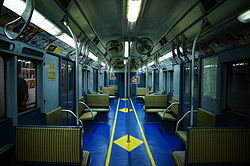R7_(New_York_City_Subway_car)
R7 (New York City Subway car)
Retired class of New York City Subway car
The R7 was a New York City Subway car model built from 1937 to 1938 for the city-operated Independent Subway System by two manufacturers under separate orders, the American Car and Foundry Company and Pullman Standard. They were a continuation of the R6 fleet and closely resemble them, except that the R7/As did not include the “CITY OF NEW YORK” lettering on the middle of the car exterior.[1] A total of 250 cars were built, all arranged as single units. Two versions were ordered: the R7, which consisted of 150 cars, numbered 1400–1549, and the R7A, which consisted of 100 cars, numbered 1550–1649.
This article needs additional citations for verification. (February 2017) |
The R7s and R7As were used primarily for increased service in Queens and the opening of the Crosstown Line. They served exclusively on all IND lines for most of their service lives, but were also used on the Eastern Division of the BMT Division's J and L lines during their final years. The R44s and R46s replaced the R7 cars, and they made their final runs in 1977. Two cars, one R7 and one R7A, have been preserved, while the rest of the fleet was scrapped.

